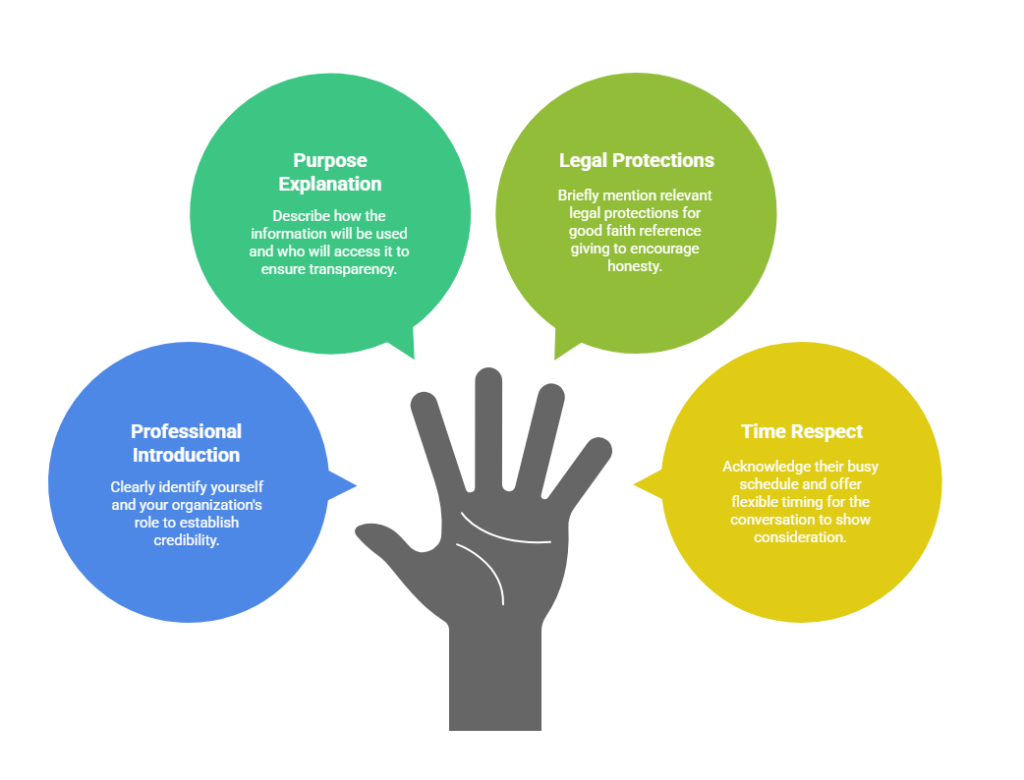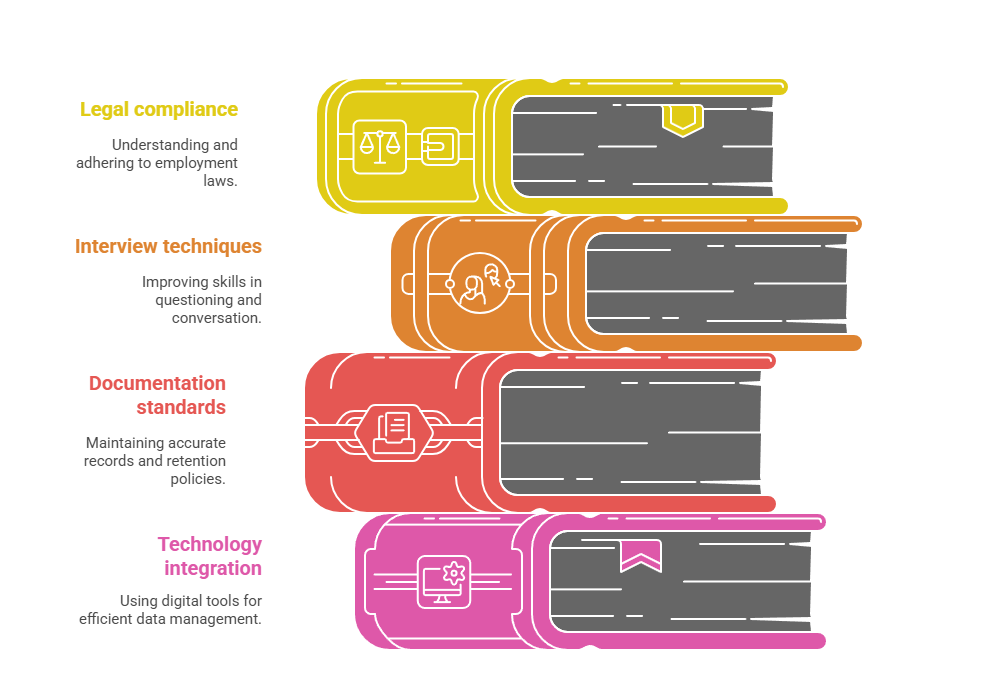Effective reference check techniques are essential for making informed hiring decisions and reducing the risk of negligent hiring in 2025. Modern employers must balance thorough candidate screening with legal compliance requirements while implementing systematic verification protocols that provide actionable insights into a candidate's past performance and character.
Key Takeaways
- Structured reference interviews yield more accurate and consistent information than informal phone calls, improving the quality of hiring decisions across your organization.
- FCRA compliance is mandatory when using third-party services for employment reference verification, requiring proper disclosure and candidate consent procedures.
- Documentation protocols protect your organization from legal liability while creating a transparent record of your background screening process.
- Multiple reference sources provide a comprehensive view of candidate performance, including supervisors, colleagues, and professional contacts from different time periods.
- Training HR teams on proper reference check methodology ensures consistent application of best practices and reduces the risk of legal violations.
- Integration with background checks creates a complete employment verification process that addresses both factual information and subjective performance insights.
Understanding Reference Check Fundamentals

Reference check techniques form the cornerstone of comprehensive background screening programs in 2025. These systematic approaches serve as a critical component in the employment verification process. Modern HR professionals rely on these methods to gather valuable information about candidates. Furthermore, these techniques help employers make informed decisions while maintaining compliance with employment law requirements.
The distinction between reference checks and traditional background checks lies in their focus and methodology. Background check reference verification typically involves structured conversations with former employers, supervisors, and professional contacts. This process helps assess candidate suitability through direct communication. Additionally, this approach complements criminal background checks and employment history verification by providing subjective insights into work performance.
Professional reference verification serves as a bridge between objective background investigation data and subjective workplace compatibility factors. Modern reference check training methods emphasize the importance of consistency, documentation, and legal compliance. Consequently, HR professionals must understand that effective candidate screening requires both factual verification and qualitative assessment. This comprehensive approach ensures better hiring outcomes and reduces potential risks associated with poor hiring decisions.
Legal Framework and Compliance Requirements
FCRA Compliance in Reference Verification
The Fair Credit Reporting Act governs many aspects of employment reference checks, particularly when third-party services conduct the verification process. FCRA compliance requirements mandate specific disclosure procedures, candidate consent protocols, and adverse action notifications. These requirements apply when reference information influences hiring decisions. Moreover, organizations must understand these regulations to avoid costly violations and legal challenges.
Employment law requirements vary significantly across jurisdictions in 2025. This variation makes it essential for organizations to understand both federal and state-specific regulations. Reference check liability can arise from improper procedures, inadequate documentation, or failure to follow established protocols. Therefore, organizations must implement comprehensive policies that address these legal considerations while maintaining effective screening practices.
State and Federal Regulation Updates
Recent regulatory changes in 2025 have expanded protections for job applicants during the reference checking process. Many states now require explicit consent before contacting references. Additionally, some jurisdictions have implemented new restrictions on the types of questions employers can ask. These changes require organizations to update their reference check policies and training programs accordingly.
| Compliance Area | 2025 Requirements | Implementation Priority |
| Consent Procedures | Written authorization required | High |
| Question Restrictions | Job-related inquiries only | High |
Strategic Planning for Reference Check Programs
Developing effective reference check techniques requires careful planning and systematic implementation. The employment reference check process should align with organizational hiring goals while addressing specific risk factors. Strategic planning ensures that reference verification activities provide maximum value. Simultaneously, this approach minimizes legal exposure and administrative burden for HR teams.
Professional reference verification programs must balance thoroughness with efficiency in today's competitive hiring market. Organizations need clear policies defining when reference checks are required, who conducts them, and how information is documented. This systematic approach creates consistency across different hiring managers and departments. Furthermore, it ensures compliance with established procedures and reduces the risk of inconsistent application.
Implementation timelines for comprehensive reference check programs typically span 4-8 weeks. Organizations must consider training requirements, policy development, and system integration during this planning phase. Additionally, companies should establish clear metrics for measuring program effectiveness and compliance rates.
Essential Reference Check Questions and Techniques
Structured Interview Methodology
What can employers ask during reference checks depends largely on job relevance and legal restrictions in your jurisdiction. Effective reference interview techniques focus on job-related performance indicators rather than protected characteristics. The key is developing a standardized set of questions that elicit useful information. Additionally, these questions must remain legally compliant and provide actionable insights for hiring decisions.
Successful reference verification requires skilled questioning techniques that encourage honest, detailed responses. Open-ended questions typically provide more valuable information than yes/no queries. Follow-up questions help clarify initial responses and provide additional context. Moreover, these techniques help build rapport with references and increase the likelihood of obtaining comprehensive feedback.
Core performance areas to address include job responsibilities, working relationships, reliability factors, and growth potential. Each area requires specific questioning strategies and follow-up techniques. Therefore, HR professionals must develop expertise in these interviewing skills to maximize the value of each reference conversation.
Getting Honest Reference Feedback
How to get honest reference feedback often depends on the approach and relationship building during the reference conversation. Many former employers provide limited information due to liability concerns in 2025. This reluctance makes it essential to establish trust and demonstrate professionalism throughout the process. Additionally, references need reassurance about legal protections and the legitimate business purpose of the inquiry.
Building rapport with reference contacts increases the likelihood of receiving candid, useful information. Explaining the purpose of the reference check helps references understand their role in the hiring process. Demonstrating knowledge of relevant legal protections can help references feel more comfortable providing detailed feedback. Furthermore, showing appreciation for their time and insights encourages more thorough responses.

- Professional introduction: Clearly identify yourself and your organization's role in the hiring process
- Purpose explanation: Describe how the information will be used and who will have access to it
- Legal protections: Briefly mention relevant legal protections for good faith reference giving
- Time respect: Acknowledge their busy schedule and offer flexible timing for the conversation
Documentation and Record Keeping Best Practices

Reference check documentation requirements serve multiple purposes including legal protection, audit compliance, and decision justification. Proper documentation creates a clear record of the information gathering process. This documentation demonstrates adherence to established procedures and legal requirements. Moreover, comprehensive records protect organizations from potential legal challenges and provide valuable information for future reference.
Essential documentation elements include contact information verification, complete records of questions and responses, and temporal records of all activities. Organizations should establish clear retention policies for reference check records. These policies typically align with broader employment record requirements and legal obligations. Digital storage systems can facilitate organization and retrieval while ensuring appropriate access controls and confidentiality protections.
| Documentation Element | Required Information | Retention Period |
| Contact Details | Name, title, company, relationship | 3 years |
| Conversation Record | Questions asked, responses received | 3 years |
| Decision Impact | How information influenced hiring | 3 years |
Integration with Comprehensive Background Screening
Reference Checks as Part of Background Screening
Reference checks as part of background screening create a comprehensive picture of candidate suitability by combining objective verification with subjective performance assessment. This integrated approach addresses both factual accuracy and workplace compatibility factors. These factors significantly influence long-term employment success and organizational fit. Additionally, comprehensive screening helps organizations make more informed hiring decisions while reducing potential risks.
Comprehensive employee background verification typically includes multiple components working together to provide complete candidate assessment. Criminal background checks verify legal compliance and identify potential risk factors. Employment history verification confirms factual accuracy and validates candidate claims. Meanwhile, reference checks provide performance insights from previous work experiences and help assess cultural fit.
The integration process requires careful coordination between different screening activities to avoid redundant questions while ensuring comprehensive coverage. This approach maximizes the value of each screening component. Furthermore, it minimizes the administrative burden on references and HR staff while providing thorough candidate evaluation.
Timing and Sequencing Considerations
Optimal timing for reference checks within the broader screening process can significantly impact their effectiveness. Most organizations conduct reference checks after initial background verification but before final hiring decisions. This sequencing allows HR professionals to address any concerns or inconsistencies that emerge. Additionally, it provides an opportunity to verify information discovered during other screening activities.
Pre-employment screening coordination becomes crucial when multiple vendors or internal teams are involved. Clear communication protocols ensure that references are not contacted multiple times for similar information. Moreover, coordinated timing helps maintain positive relationships with reference sources and demonstrates professionalism throughout the process.
Training and Development for Reference Check Excellence
Reference check training programs ensure consistent application of best practices across HR teams and hiring managers. Comprehensive training addresses legal compliance, questioning techniques, documentation requirements, and integration with broader screening processes. Training programs must be updated regularly to reflect changing legal requirements and industry best practices. Additionally, organizations should provide ongoing education to maintain skill levels and address emerging challenges.
HR reference verification training should cover both technical skills and soft skills necessary for effective reference interviews. Technical components include legal requirements, documentation procedures, and compliance protocols that protect the organization. Soft skills encompass communication techniques, rapport building, and effective questioning strategies that elicit valuable information. Moreover, training should address common challenges and provide practical solutions for difficult reference situations.
Professional development opportunities help HR staff advance their screening methodology expertise while staying current with industry trends. Investment in comprehensive training typically results in improved hiring decisions and reduced legal exposure. Furthermore, well-trained staff can more effectively navigate complex reference situations and obtain higher-quality information from reference sources.

- Legal compliance modules: FCRA requirements, employment law basics, liability prevention strategies
- Interview technique development: Question formulation, conversation management, information gathering skills
- Documentation standards: Proper record keeping, retention policies, audit preparation procedures
- Technology integration: Digital tools, automated systems, data management best practices
Technology and Tools for Modern Reference Checking
Modern employment screening education increasingly emphasizes technology integration and automated tools that streamline reference check processes. These digital solutions maintain quality and compliance standards while reducing administrative burden. Technology platforms can facilitate scheduling, documentation, and follow-up activities efficiently. Moreover, automated systems ensure consistent application of established procedures across all reference checks.
Digital platforms range from simple documentation templates to comprehensive background check methodology training systems. These tools integrate multiple screening components into cohesive workflows. The key is selecting technology solutions that enhance rather than complicate existing processes. Additionally, chosen tools should provide clear value for HR teams and hiring managers while maintaining compliance requirements.
Automated reference checking systems can track completion rates, manage documentation requirements, and ensure consistent follow-up procedures. However, technology should support rather than replace the human judgment essential for effective reference verification. Furthermore, personal relationship-building skills remain crucial for obtaining honest, detailed feedback from reference sources.
| Technology Type | Primary Benefits | Implementation Considerations |
| Automated Scheduling | Time efficiency, coordination | Integration with existing systems |
| Digital Documentation | Compliance tracking, organization | Security and access controls |
| Analytics Platforms | Performance metrics, insights | Training requirements for staff |
Common Challenges and Solutions
Overcoming Reference Reluctance
Many organizations encounter difficulty obtaining detailed reference information due to former employer policies or liability concerns. Employment screening attorney consultation can help develop strategies for addressing these challenges. These strategies must maintain legal compliance and effective screening practices simultaneously. Additionally, organizations need creative approaches to encourage reference participation while respecting legitimate concerns.
Professional approaches that demonstrate competence and understanding of legal protections often improve reference cooperation. Flexible scheduling accommodates reference availability and preferences effectively. Clear purpose explanations help references understand the importance of their input in the hiring process. Moreover, providing written questions in advance can help references prepare thoughtful, detailed responses.
Reference reluctance has increased significantly in 2025 due to heightened awareness of legal risks. Organizations must adapt their strategies to address these concerns while maintaining effective screening programs. Building long-term relationships with frequently used references can improve cooperation rates over time. Furthermore, demonstrating consistent professionalism and respect for reference time encourages continued participation.
Ensuring Consistency and Fairness
Consistent application of reference check procedures ensures fair treatment of all candidates while reducing discrimination claims risk. Standardized questions, documentation procedures, and evaluation criteria help maintain objectivity throughout the screening process. Regular program evaluation identifies potential inconsistencies or bias in reference check procedures. Additionally, ongoing assessment helps organizations refine their processes while ensuring continued compliance.
Quality assurance measures should include regular review of documentation, interviewer training updates, and feedback collection from both candidates and references. These measures help identify areas for improvement and ensure consistent application of policies. Moreover, regular audits can reveal potential compliance issues before they become significant problems.
Measuring Reference Check Program Effectiveness
Organizations must establish clear metrics to evaluate their reference check programs' success and identify areas for improvement. Key performance indicators should include completion rates, time to completion, quality of information obtained, and correlation with hiring success. Regular measurement helps organizations optimize their processes. Additionally, data analysis can reveal trends and patterns that inform program improvements.
Cost-effectiveness analysis helps organizations understand the return on investment for their reference checking activities. This analysis should consider direct costs, staff time, and the value of improved hiring decisions. Furthermore, measuring the impact on employee retention and performance provides insight into long-term program benefits.
Feedback collection from hiring managers, candidates, and references provides valuable insights into program effectiveness. This feedback helps identify pain points and areas for improvement. Moreover, regular surveys can track satisfaction levels and identify emerging challenges before they impact program success.
- Completion metrics: Percentage of required references obtained within target timeframes
- Quality indicators: Depth and usefulness of information gathered from reference conversations
- Legal compliance: Adherence to documentation requirements and regulatory obligations
- Cost analysis: Total program costs compared to hiring decision improvement benefits
Future Trends in Reference Checking
The reference checking landscape continues to evolve rapidly in 2025, driven by technological advances and changing workplace dynamics. Artificial intelligence and machine learning tools are beginning to supplement traditional reference checking methods. These technologies can help identify patterns and inconsistencies in reference information. However, human judgment remains essential for interpreting nuanced feedback and building relationships with reference sources.
Remote work trends have changed the nature of professional relationships and reference availability. References may have limited direct supervision experience with candidates in remote work environments. This shift requires adapted questioning techniques and expanded reference networks. Additionally, organizations must consider how to verify remote work performance effectively through reference conversations.
Social media integration and digital networking platforms are creating new opportunities for reference verification. Professional networking sites provide additional sources of information about candidate performance and reputation. However, organizations must carefully navigate privacy concerns and legal restrictions when using these resources. Furthermore, traditional reference checking methods remain the gold standard for obtaining reliable, detailed performance information.
Cost-Benefit Analysis of Reference Check Programs
Understanding the financial impact of comprehensive reference check programs helps organizations make informed decisions about resource allocation. Direct costs include staff time, technology investments, and potential third-party service fees. Indirect costs encompass training expenses, system maintenance, and compliance monitoring activities. However, these investments typically generate significant returns through improved hiring decisions and reduced turnover costs.
The average cost of a bad hire in 2025 ranges from 30% to 150% of the position's annual salary, depending on the role level. Effective reference checking can significantly reduce these costs by identifying potential performance issues before hiring. Additionally, thorough reference verification helps organizations avoid legal liability associated with negligent hiring practices.
Return on investment calculations should consider both quantitative and qualitative benefits of comprehensive reference checking. Quantitative benefits include reduced turnover, decreased recruitment costs, and improved productivity metrics. Qualitative benefits encompass enhanced workplace culture, better team dynamics, and reduced management time spent addressing performance issues.
Global Considerations for Reference Checking
Multinational organizations face unique challenges when implementing reference check programs across different jurisdictions. Privacy laws vary significantly between countries, affecting how reference information can be collected, stored, and used. The European Union's GDPR, for example, imposes strict requirements on personal data processing. Additionally, cultural differences may impact reference-giving practices and the types of information typically shared.
Cross-border reference checking requires understanding of local laws, business practices, and communication preferences. Time zone differences can complicate scheduling and follow-up activities. Language barriers may require translator services or multilingual staff capabilities. Moreover, different professional networking cultures may affect reference availability and willingness to provide detailed feedback.
Organizations operating globally must develop flexible reference checking policies that accommodate local requirements while maintaining consistent quality standards. This approach requires significant investment in training and compliance monitoring. Furthermore, technology solutions must support multiple languages and regulatory frameworks to be effective across diverse markets.
Conclusion
Mastering reference check techniques in 2025 requires a comprehensive approach that balances thoroughness with efficiency while maintaining strict compliance with evolving legal requirements. Organizations that invest in proper training, documentation, and integration with broader background screening programs typically achieve better hiring outcomes and reduced legal exposure. The key to success lies in systematic implementation of proven methodologies combined with ongoing evaluation and improvement of reference verification processes. Modern employers must view reference checks as an essential component of comprehensive candidate assessment rather than a simple administrative requirement, particularly as the competitive talent market demands more sophisticated screening approaches.
Frequently Asked Questions
What questions are legally permissible during employment reference checks?
Employers can ask job-related questions about performance, work quality, attendance, teamwork, and specific skills relevant to the position. Avoid questions about protected characteristics such as age, religion, marital status, or disability status unless directly related to essential job functions with proper legal justification. Focus on behaviors and achievements that directly relate to job requirements and organizational needs.
How many references should employers typically check for each candidate?
Most organizations check 2-3 professional references for standard positions, with additional references for senior or high-risk roles. Include a mix of supervisors, colleagues, and direct reports when possible to gain comprehensive performance insights from different perspectives. Consider the role's impact and responsibility level when determining the appropriate number of references to contact.
What documentation is required for reference check compliance?
Document the reference source, relationship to candidate, questions asked, responses received, date and time of contact, and any follow-up actions. Maintain records according to your organization's retention policy, typically 1-3 years depending on local employment law requirements. Ensure all documentation is factual, objective, and focused on job-related information rather than personal opinions.
How should employers handle negative reference information?
Verify negative information through additional sources when possible, focus on job-related concerns, and ensure fair consideration of the candidate's overall qualifications. Follow adverse action procedures if the information significantly impacts the hiring decision, including proper notification and opportunity for candidate response. Document the decision-making process thoroughly to demonstrate fair and consistent treatment.
Can employers conduct reference checks without candidate permission?
While not always legally required, obtaining candidate consent demonstrates professionalism and helps ensure cooperation from references. Some jurisdictions require explicit consent, and FCRA compliance mandates permission when using third-party screening services for reference verification. Best practice involves obtaining written consent before beginning any reference checking activities.
What are the key differences between reference checks and background checks?
Reference checks involve subjective conversations about performance and character with former employers or colleagues, while background checks typically verify objective information like criminal history, employment dates, and education credentials. Both serve different but complementary purposes in comprehensive candidate screening, with reference checks providing qualitative insights that complement quantitative background verification data.
Additional Resources
- FCRA Compliance Guide for Employers
https://www.ftc.gov/business-guidance/resources/using-consumer-reports-what-employers-need-know - SHRM Reference Check Best Practices
https://www.shrm.org/resourcesandtools/tools-and-samples/how-to-guides/pages/howtoconductreferencebackgroundchecks.aspx - EEOC Guidelines on Employment Screening
https://www.eeoc.gov/laws/guidance/arrest-and-conviction-records-employment-decisions - Legal Reference Check Question Templates
https://www.nolo.com/legal-encyclopedia/free-books/employee-rights-book/chapter9-5.html - Professional Background Screening Association Resources
https://www.professionalbackground.org/ - Department of Labor Employment Verification Guidelines
https://www.dol.gov/agencies/whd/workers/rights - State-by-State Reference Check Law Summary
https://www.workplacefairness.org/reference-checks
Still have questions?
Get in touch with our team today for a personalized demo and discover how our tailored volume pricing and packages can drive results for your business!
How useful was this page?*
Note: your comments are anonymous. We use them to improve the website. Do not include any personal details.
Visit our FCRA Compliance Tool or leave a message here if you need a response.
From the blog Explore the GCheck Content Hub

Prescription Drugs That Show Up on Drug Tests: A Compliance Guide
4 Dec, 2025 • 18 min read
Seasonal Employee Background Checks: Protecting Your Business During Peak Hiring Periods
4 Dec, 2025 • 22 min read
Background Check for Volunteers vs Employees: Legal Frameworks and Screening Protocol Development
3 Dec, 2025 • 14 min readThe information provided in this article is for general informational and educational purposes only and should not be construed as legal advice or a substitute for consultation with qualified legal counsel. While we strive to ensure accuracy, employment screening laws and regulations—including but not limited to the Fair Credit Reporting Act (FCRA), Equal Employment Opportunity Commission (EEOC) guidelines, state and local ban-the-box laws, industry-specific requirements, and other applicable federal, state, and local statutes—are subject to frequent changes, varying interpretations, and jurisdiction-specific applications that may affect their implementation in your organization. Employers and screening decision-makers are solely responsible for ensuring their background check policies, procedures, and practices comply with all applicable laws and regulations relevant to their specific industry, location, and circumstances. We strongly recommend consulting with qualified employment law attorneys and compliance professionals before making hiring, tenant screening, or other decisions based on background check information.

